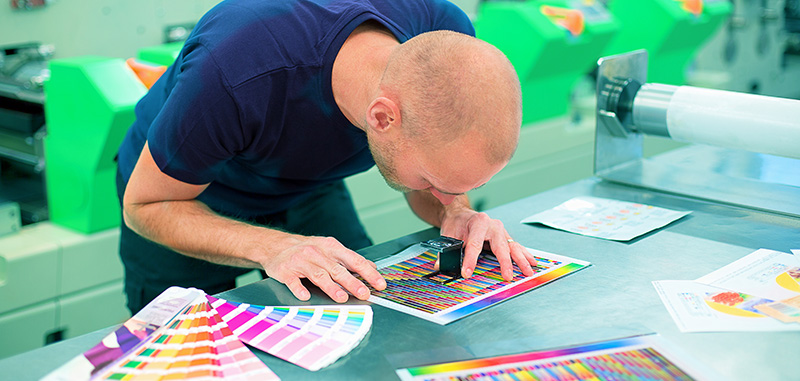
Everyone makes mistakes, so the old saying goes. But while to err is human, sometimes you can save yourself a world of headaches by avoiding errors in the first place.
Product labels are one area where getting it right the first time pays off. For such a small sliver of material, a label has a big impact on the success of your products and the perception of your brand. Sloppy, peeling labels, for example, may lead potential buyers to think a product is cheaply made, regardless of its actual quality.
Fortunately, many brands understand the critical significance of product labels. We know this because an article from last January, “5 Product Label Printing Mistakes to Avoid,” was our most popular post of 2020.
So, we thought it would be useful to our readers to revisit the topic before we close out the year. Here are five more common label mistakes, and most importantly, how to avoid making them:
1. Mismatched Colors Diluting Brand Identity
Brands put a lot of careful planning into choosing their brand colors. And often, their choices are extremely specific. In other words, not just “red” or “brown,” but “Coca-Cola red” or “UPS brown.” These are shades that are instantly identifiable with a brand without any text or imagery.
Your product labels should capture your brand colors precisely. “Close enough” may not be close enough for your brand’s most ardent fans — or for the consumers who make split-second choices based on fleeting impressions.
A number of factors can affect how a color looks on a product label. Many people don’t realize the printing surface can make a difference. For example, paper can absorb ink, altering the intensity of a color. Darker surfaces, such as Kraft paper, can blend visually with ink to change its appearance.
Not every conceivable color is achievable through every printing process. Label companies typically have access to a range of hues, determined by their technology and resources.
Several presses at The Label Printers can replicate colors in the extended CMYK gamut (the standard CMYK inks, plus orange, violet, and green), allowing nearly a million printing colors. Nevertheless, some colors still lie outside that range, requiring the use of (potentially more expensive) spot colors.
However, you don’t need to be an expert on color specifications or label printing to get a product label that matches your brand colors exactly. An experienced label company will know the right questions to ask and will lead you through your options to get as close to your distinctive brand identity as possible.
2. Compliance Issues Leading to Legal Trouble
Nearly every industry must comply with specific regulations concerning the information provided on product labels and the shape, size, and format of certain label types.
Here is just a sampling of some of the many label regulations you might encounter:
- Industrial safety labels must use colors (red, orange, yellow, green, blue, purple, white, brown, gray, and black) defined by ANSI Z535.1, which describes each color’s ink formulation and sets acceptable tolerances.
- Food and beverage labels must list product ingredients and indicate weight and volume in accordance with government bodies, such as the U.S. Food and Drug Administration.
- Electronics products and components must include carcinogen warnings if they are to be sold in California.
- Health and personal care items may be categorized as pharmaceuticals in the eyes of regulators. Therefore, they must include (in the U.S.) a drug facts label that lists active ingredients, warnings, and dosage instructions, among other things.
Brands that fail to comply with their industry’s regulatory requirements risk costly fines and lawsuits. If you’re not sure what the law says about your product label, partner with a label company that’s familiar with your industry and target market.
3. Counterfeit Goods Becoming Brand Identity Theft
The sale of counterfeit goods is out of control around the world, largely thanks to the growth of e-commerce, which makes it easier than ever before to reach consumers with fake products. Nearly every product can be counterfeited these days, from fragrances to fashion to pharmaceuticals.
When your products fall victim to counterfeiting, it’s not just your (often unsuspecting) customers who suffer. Counterfeiting can do serious damage to your reputation.
Fortunately, your brand is not helpless against counterfeiting. There are numerous anti-counterfeiting strategies at your disposal, with more being devised regularly. Many of these brand protection strategies center around product labels. Label-based brand protection features include:
- Overt elements such as holography, color-shifting ink, serial numbers, and barcodes, which thwart reproduction.
- Covert elements such as invisible ink, microprinting, and forensic features that help authorities, retailers, and consumers identify genuine products.
- Track and trace systems that help brands secure their supply chains.
If counterfeiting is a concern for your brand, speak to your label printer about the brand protection options they offer.
4. Sustainability Oversights Losing You Customers
Modern consumers value sustainability. Younger generations especially, including millennials and the members of Generation Z, care deeply about their environmental impact, and they choose brands that share their priorities.
A Nielsen study found that 53% of millennials would be willing to pay more for products that come in environmentally friendly packaging.
The production of product labels, like every other packaging element, consumes energy and resources. But you can limit your label’s environmental footprint by making smart choices about label materials (for example, opting for recycled paper and water-based inks), using less material where possible, and working with a label company that takes sustainability seriously.
5. Ordering Mistakes Inflating Costs or Wasting Labels
Every resource counts in modern manufacturing. Companies prefer to run lean, reducing waste and focusing only on that which creates value for customers.
Unfortunately, if you’re not careful, waste and inefficiency can creep into the label production process.
For example, if you order more labels than you need to fulfill your immediate demand, you will have to find space to store the excess. On the other hand, the cost-saving advantages of volume pricing can be significant in label printing.
The right label company will act not merely as an order-taker but as a partner, suggesting strategies for reducing waste, increasing efficiency, saving money, and striking the perfect balance between your current needs and your long-term goals.
Are you beginning to see a pattern here? For each of these five common label mistakes, the solution involves working with a label company with the experience, expertise, and customer-service focus to guide you through the sometimes-confusing world of product labels.
To partner with such a company for your next label, contact The Label Printers today.


